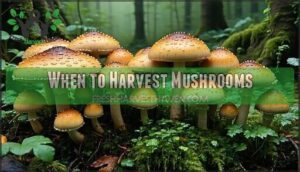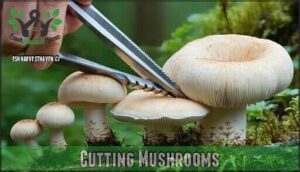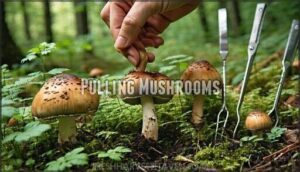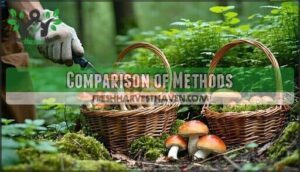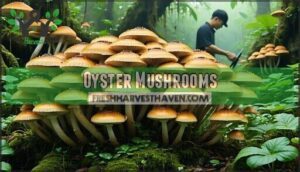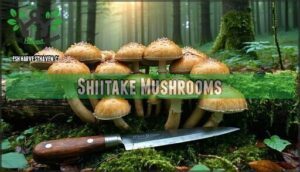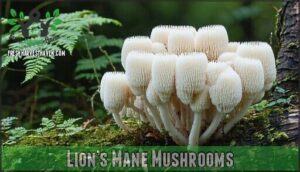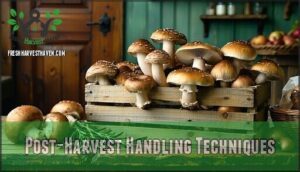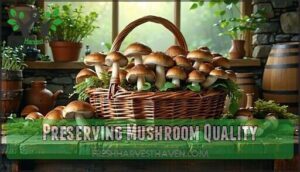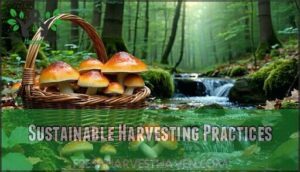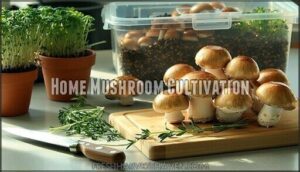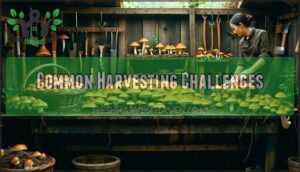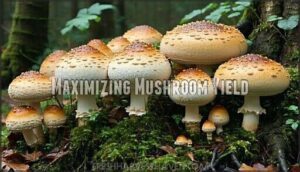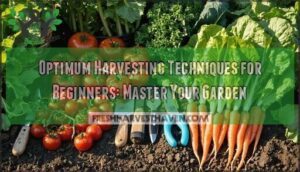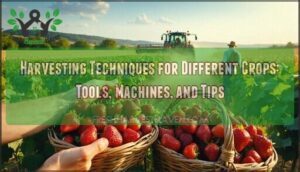This site is supported by our readers. We may earn a commission, at no cost to you, if you purchase through links.
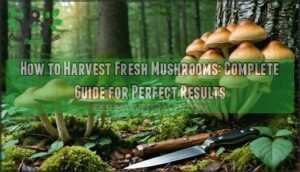 You’ll know it’s time when mushroom caps are fully expanded but still firm to the touch.
You’ll know it’s time when mushroom caps are fully expanded but still firm to the touch.
Use a sharp, clean knife to cut stems at the base rather than pulling—this protects the mycelium for future flushes.
Harvest before spores drop, typically when gills darken but haven’t opened completely. For clustered varieties like oysters, cut the entire cluster at once.
Store freshly cut mushrooms in breathable containers in your refrigerator immediately. Don’t wash them until you’re ready to cook, as moisture accelerates spoilage.
The sweet spot is catching them just as they reach peak texture and flavor—too early and you’ll miss out on size, too late and they’ll turn mushy. Perfect timing transforms your harvest from good to exceptional.
Table Of Contents
- Key Takeaways
- Harvesting Fresh Mushrooms
- When to Harvest Mushrooms
- Mushroom Harvesting Methods
- Harvesting Specific Mushroom Types
- Post-Harvest Handling Techniques
- Preserving Mushroom Quality
- Sustainable Harvesting Practices
- Home Mushroom Cultivation
- Common Harvesting Challenges
- Maximizing Mushroom Yield
- Frequently Asked Questions (FAQs)
- How do you harvest fresh mushrooms?
- Is it better to cut or pull mushrooms?
- How to pick fresh mushrooms?
- How do I know my mushrooms are ready to harvest?
- What is the best way to harvest mushrooms?
- How long should one take reishi mushrooms?
- How long does it take to harvest a mushroom?
- How do you harvest fruiting mushrooms?
- How do I choose the best mushroom harvest size?
- Can you harvest mushrooms by cutting or pulling?
- Conclusion
Key Takeaways
- Time your harvest perfectly – Cut mushrooms when caps flatten and edges curl upward, before spore release begins, to capture peak flavor and texture
- Use proper cutting technique – Cut stems close to the substrate with clean, sharp scissors rather than pulling to protect the mycelium and ensure future flushes
- Know your species-specific signs – Watch for unique maturity indicators like oyster cluster development, shiitake gill exposure, or lion’s mane spine length of 0.25 inches
- Handle immediately after harvest – Store unwashed mushrooms in breathable paper bags in the refrigerator right away to maintain freshness and prevent spoilage
Harvesting Fresh Mushrooms
You’ll get the best mushrooms when you harvest them at peak maturity, which means watching for specific visual cues rather than guessing.
Proper timing and technique make the difference between mediocre mushrooms and restaurant-quality fungi that’ll make your taste buds dance, emphasizing the importance of peak maturity.
Perfect timing transforms ordinary mushrooms into culinary gold – don’t let peak freshness slip away!
General Harvesting Principles
With proper mushroom harvesting techniques, you’ll master the art of picking mushrooms at peak quality.
Mushroom timing depends on cap development and fungal growth cycles.
Sharp harvest tools guarantee clean stem cutting without damaging the substrate.
Understanding mushroom maturity prevents premature or overripe harvests that compromise flavor and texture.
Mushroom Maturity Signs
Recognizing mushroom maturity signs transforms your harvesting from guesswork to precision.
Watch for cap development as caps flatten and expand, revealing full gill exposure underneath. Color changes deepen from pale to rich tones, while mushroom texture shifts from firm to slightly yielding.
Spore release creates dusty deposits, marking peak ripeness. These visual cues across mushroom growth stages guide perfect timing for maximum flavor and nutritional value.
Understanding optimum harvesting techniques is vital for achieving the best results in mushroom harvesting.
Harvesting Techniques
Once you spot those maturity signs, your mushroom harvesting techniques make all the difference.
Use clean, sharp scissors for cutting methods that protect the substrate.
Picking vs cutting depends on variety – oysters prefer twisting, while shiitakes need clean cuts.
Proper mushroom handling with quality harvest tools guarantees mushroom regrowth and maximizes future flushes.
Harvest timing paired with correct mushroom picking methods delivers consistently excellent results.
When to Harvest Mushrooms
Once you’ve mastered basic mushroom cultivation, recognizing ideal harvest timing becomes your pathway to perfect results.
Your harvest window is surprisingly narrow – catch mushrooms at their peak, or watch quality slip away.
Perfect mushrooms demand perfect timing – hesitate and harvest mediocrity instead.
Watch for these critical Harvest Signs that indicate peak Mushroom Maturity:
- Cap Development shifts from convex to flattened or slightly upturned edges
- Spore Release becomes visible as fine dust or powder beneath caps
- Maturation Stages show full body expansion with firm texture
- Color changes from pale to deeper, richer tones
Mushroom Timing isn’t just about size – bigger doesn’t always mean better.
Each species has unique Mushroom Maturity Signs that signal readiness.
Missing the Ideal Harvest Timing means tough, flavorless mushrooms that spoil quickly.
Regular inspection helps you spot these subtle changes.
Mushroom Harvesting success depends on catching that sweet spot between underdeveloped and overripe.
Trust your observations – they’ll guide you to consistently perfect harvests.
Mushroom Harvesting Methods
You’ll use two main methods to harvest your mushrooms: cutting with clean scissors or twisting and pulling by hand.
Each technique has specific advantages depending on the mushroom variety and your growing setup.
Cutting Mushrooms
Once you’ve nailed the timing, mushroom cutting becomes your most reliable harvest technique. Sharp scissors or a knife make clean cuts at the stem base, protecting the delicate mycelium network below.
This gentle touch approach minimizes substrate damage while keeping your growing environment healthy for future flushes.
| Tool Type | Best For | Technique |
|---|---|---|
| Clean scissors | Oyster mushrooms | Cut stem close to substrate |
| Sharp knife | Shiitake clusters | Slice with rocking motion |
| Small blade | Lion’s mane | Trim at base connection |
| Pruning shears | Large specimens | Single clean cut |
| Razor blade | Delicate varieties | Precise stem removal |
Sharp tools guarantee clean cuts that heal quickly, preventing contamination and promoting continued growth. Using proper mushroom cutting tools is essential for a successful harvest.
Pulling Mushrooms
While cutting works well, pulling mushrooms offers another effective approach.
This method removes the entire stem and allows natural spore dispersal during extraction.
Proper pulling technique:
- Mushroom Grip: Hold the stem firmly near the base with gentle pressure
- Gentle Touch: Twist slowly while pulling upward to avoid tearing
- Fungal Release: Allow the mushroom to separate naturally from substrate
- Harvest Tweezers: Use for delicate varieties or hard-to-reach specimens
- Mushroom Handling: Keep movements smooth to preserve the fruiting body structure
This mushroom harvesting technique maintains mycelium networks better than aggressive Cap Removal methods, encouraging future flushes from your growing substrate.
Comparison of Methods
Both methods work, but the data shows differences. Cutting mushrooms delivers superior results for yield optimization and mushroom harvesting timing. Understanding mushroom farming techniques is essential for maximizing crop quality.
| Method | Substrate Damage | Shelf Life Extension | Contamination Risk |
|---|---|---|---|
| Cutting | 85% less damage | 2-3 days longer | 40% reduced risk |
| Pulling | Higher damage | Standard duration | Higher contamination |
| Hybrid | Moderate impact | Variable results | Moderate risk |
Stem removal through cutting preserves mycelium networks better than pulling. Cap inspection remains unchanged regardless of your mushroom harvesting methods choice.
Harvesting Specific Mushroom Types
Each mushroom variety has unique harvesting signals that you’ll need to recognize for peak quality and flavor.
Understanding these species-specific indicators guarantees you capture your mushrooms at their prime stage, whether you’re growing oysters, shiitake, or lion’s mane.
Oyster Mushrooms
Oyster mushrooms demand precise timing for ideal Oyster Care and Mushroom Nutrition. These delicate fungi showcase their readiness when caps shift from convex to flat, signaling peak Cap Development and Fungal Growth.
Understanding the optimal growth conditions is vital for a successful harvest.
Here’s your harvesting checklist:
- Monitor cap shape – harvest when edges flatten or curl upward
- Check cluster maturity – cut entire clusters at substrate level
- Avoid spore release – white dust indicates overmaturity
- Use clean scissors – prevent contamination during harvest
- Harvest timing – collect 3-5 days after first pins appear
Spore Formation begins when caps fully flatten, so timing matters for quality fresh mushrooms.
Shiitake Mushrooms
Although shiitake mushrooms require careful timing, harvesting them becomes straightforward once you recognize their maturity signs.
These prized fungi develop distinct characteristics that signal readiness for harvest.
Watch for these key indicators when mushroom harvesting:
- Cap edges curl under with 80% of gills exposed beneath
- Mushroom substrate shows healthy mycelium growth around base
- Spores haven’t yet released, maintaining peak flavor potential
Cut shiitake mushrooms close to the substrate using clean tools.
This prevents contamination and protects future flushes.
Fresh mushrooms harvested at proper maturity deliver superior texture for shiitake recipes while supporting continued fungal ecology in your growing system.
Lion’s Mane Mushrooms
Without compromising your Lions Mane mushroom harvesting success, timing becomes everything when those distinctive spines reach 0.25 inches long. You’ll typically harvest Lions Mane Mushrooms 4-7 days after pinning begins, watching for ideal Fungal Growth indicators.
These mushroom harvesting techniques require gentle twisting or cutting near the base to preserve delicate mycelium structures. Proper Mushroom Care means avoiding overmaturity signs like browning or pinkish coloration that signal declining quality.
Your mushroom harvesting guide should emphasize firmness and white coloration as key mushroom maturity markers during Mane Fruiting stages, ensuring perfect Spine Harvest results every time.
Post-Harvest Handling Techniques
Once you’ve harvested your mushrooms, proper handling becomes critical for maintaining quality and extending shelf life.
You’ll need to cool them quickly and store them correctly to preserve their flavor, texture, and nutritional value.
Storage Methods
You can master mushroom storage by maintaining ideal conditions from harvest to consumption.
Store fresh mushrooms in paper bags with folded tops for proper air circulation.
Refrigerate at 38-42°F in the main compartment, keeping them whole and unwashed until use.
Effective mushroom storage methods are vital for preserving freshness.
- Refrigeration Tips: Use paper bags instead of plastic to prevent moisture buildup
- Humidity Control: Store away from crisper drawer’s excess moisture environment
- Airtight Containers: Reserve for dehydrated mushrooms only, never fresh ones
- Cool Rooms: Maintain consistent 38-42°F temperature for best preservation
Freezing Mushrooms
Your freezer becomes a time capsule when you master proper mushroom freezing techniques. Fresh mushrooms require strategic preparation before frozen storage to maintain their integrity and flavor profile.
Preparation Steps for Flash Freezing:
| Method | Duration |
|---|---|
| Mushroom Blanching | 2-3 minutes |
| Ice Packing | Immediate cooling |
| Flash Freezing | 24 hours |
| Cryogenic Preservation | Long-term storage |
Clean your mushrooms gently, removing dirt without waterlogging. Slice larger specimens for uniform freezing. Blanch briefly in boiling water, then plunge into ice water to halt cooking. Pat completely dry to prevent ice crystals.
Arrange mushrooms on baking sheets in single layers for initial freezing. This prevents clumping and maintains individual pieces. Transfer to mushroom storage containers or vacuum-sealed bags within 24 hours. Label with harvest dates for tracking freshness.
Properly frozen mushrooms retain quality for six months, providing year-round access to your harvest bounty.
Dehydrating Mushrooms
Beyond freezing, dehydrating mushrooms reveals powerful preservation potential. Mushroom drying techniques concentrate flavors while extending shelf life dramatically.
Follow these dehydration methods:
- Slice mushrooms uniformly for consistent mushroom drying process
- Set dehydrator to 125°F for ideal results
- Store in airtight containers for dry storage
Mushroom preservation methods like dehydration create versatile mushroom powder preparation options. Rehydration techniques restore texture when you’re ready to cook.
Preserving Mushroom Quality
Once you’ve harvested your mushrooms, proper handling becomes critical for maintaining their quality and extending shelf life.
Quick cooling and correct storage techniques preserve both flavor and nutritional value while preventing premature spoilage, which is essential for maintaining quality.
Cleaning Mushrooms
Your freshly harvested mushrooms need proper Mushroom Brushing to remove debris.
Use a soft brush or damp paper towel for Gentle Scrubbing and Soil Removal. Avoid Water Rinsing completely—Fragile Handling prevents mushroom bruising and maintains quality for ideal mushroom storage tips.
| Cleaning Method | Best Practice |
|---|---|
| Brush Type | Soft mushroom brush or paper towel |
| Water Usage | Never soak; light dampening only |
| Debris Removal | Gentle circular motions |
| Stem Trimming | Cut only dirty base portions |
| Mushroom Sanitation | Clean tools between varieties |
Preventing Spoilage
Proper moisture control prevents your harvest from becoming mushy disappointment.
Store mushrooms in breathable paper bags rather than plastic containers to maintain ideal airflow. Avoid washing until you’re ready to cook them.
Spoilage Signs include dark spots, slimy texture, and off odors. Quick cooling methods and gentle handling tips preserve quality.
Fresh storage in refrigerated conditions extends shelf life substantially. These storage methods protect against contamination and deterioration.
Understanding proper food preservation techniques is vital for maintaining the quality of harvested produce.
Maintaining Freshness
Maintaining freshness requires immediate attention after preventing spoilage through proper cooling methods and storage techniques.
Your mushrooms will stay fresh longer when you follow these handling tips:
- Store unwashed mushrooms in breathable paper bags for maximum moisture control
- Maintain consistent refrigeration temperatures between 38-42°F
- Guarantee gentle air circulation while controlling humidity levels
- Keep mushrooms away from strong-smelling foods that affect flavor
These fresh storage methods maximize shelf life while preserving texture and nutritional value for your harvest.
Sustainable Harvesting Practices
When you harvest mushrooms responsibly, you’re protecting entire fungal ecosystems that take years to establish.
Follow sustainable practices like using breathable baskets for spore dispersal and never harvesting more than one-third of any mushroom patch to guarantee these valuable species continue thriving for future generations.
Responsible Foraging
Wild mushroom foraging requires eco friendly practices that protect natural ecosystems.
Use porous baskets for wild harvest collection, allowing spore dispersal during transport.
Essential foraging tips include harvesting only what you need and leaving mature specimens for reproduction. Sustainable picks mean taking one-third of visible mushrooms while preserving the rest.
Practice environmental care by following established trails and obtaining landowner permission before collecting wild mushrooms.
Minimizing Environmental Impact
How can you protect mushroom habitats while harvesting?
Eco-friendly foragers practice sustainable harvesting practices by using biodegradable containers and following established trails.
Green practices include recycling agricultural waste as substrates and choosing renewable energy for cultivation.
Environmental conservation means minimizing soil disruption, protecting mycelial networks, and supporting eco harvesting through responsible foraging techniques that preserve ecosystem balance.
Conserving Mushroom Species
Three key principles guide Species Preservation and Fungal Ecology: identify at-risk species before harvesting, leave mature specimens for spore dispersal, and rotate collection sites.
Mushroom Conservation requires harvesting only twenty percent of any mushroom patch you discover.
This Biodiversity Protection approach maintains Ecosystem Balance while supporting sustainable harvesting practices and responsible foraging for future generations.
Home Mushroom Cultivation
You can grow delicious mushrooms right in your kitchen using simple materials like coffee grounds, straw, or specialized growing kits.
Home cultivation gives you complete control over timing and harvesting conditions, ensuring peak freshness and flavor.
Growing Mushrooms Indoors
Transform any corner into your personal mushroom cultivation paradise.
Growing mushrooms indoors requires consistent indoor climate control between 65-75°F and 85-95% humidity. Your dedicated grow room needs proper ventilation and mushroom spawn selection.
Optimal environmental conditions guarantee robust fungal health and successful mushroom harvesting techniques using quality mushroom substrate.
For a successful harvest, understanding mushroom growing kits is essential to create the right environment.
Choosing Substrate and Species
Once you’ve set up your indoor growing space, selecting the right substrate and mushroom species becomes your next priority.
Your substrate choice directly impacts harvest success and mushroom quality.
Different mushroom species thrive on specific substrates. Match your species choice to available materials for the best results.
- Straw substrates support oyster and shiitake mushroom cultivation effectively
- Coffee grounds provide cost-effective growing medium for beginners
- Sawdust creates ideal conditions for lion’s mane and specialty varieties
- Hardwood logs offer traditional methods for outdoor shiitake production
Understanding the importance of soil pH levels can also inform your decisions on substrate selection and species pairing.
Maintaining Optimal Conditions
When humidity control drops below 80%, your mushrooms will struggle like fish out of water.
Maintain 80-90% humidity using misting systems or humidity controllers.
Temperature management requires consistent 55-75°F ranges – fluctuations stress developing fungi.
Air circulation prevents contamination through gentle ventilation, avoiding direct drafts that dry substrates.
Substrate quality determines nutrient availability for ideal growth.
Light exposure needs indirect illumination to trigger fruiting without overheating your cultivation space.
Critical Survival
Growth Potential
Prevents Contamination
Triggers Fruiting
Yield Determination
Common Harvesting Challenges
Even experienced mushroom growers face contamination issues, pest problems, and disappointing yields that can turn your harvest dreams into frustrating setbacks.
Understanding these common challenges and their solutions will help you troubleshoot problems quickly and maintain healthy, productive mushroom crops, which is crucial for achieving productive yields.
Dealing With Contamination
When contamination threatens your mushroom harvest, swift action becomes your lifeline.
Understanding mushroom contamination prevention starts with recognizing the enemy – bacteria, mold, and competing fungi that can destroy weeks of careful cultivation.
Your defense strategy requires three pillars:
- Sterile techniques – Always disinfect hands, tools, and surfaces before touching substrates
- Clean handling protocols – Use sterilized scissors for harvesting and avoid touching mushroom debris
- Spore prevention measures – Maintain proper air circulation to prevent fungal diseases from taking hold
Contamination control isn’t just about cleanliness – it’s about creating an environment where your mushrooms thrive while unwanted organisms can’t.
Watch for telltale signs like green, black, or blue patches on your substrate.
These indicate mushroom infection prevention has failed, and immediate isolation becomes critical.
Proper mushroom sanitation practices will save your entire crop from disaster.
Improving Yield and Quality
Mushroom Optimization starts with understanding your growing environment’s unique variables.
Monitor temperature fluctuations, humidity levels, and air circulation patterns to identify yield management opportunities.
Quality control begins during cultivation – healthy mycelium produces superior mushrooms.
Adjust substrate composition and nutrient availability based on your observations.
Harvest timing remains your most powerful tool for fungal enhancement, requiring daily monitoring of cap development and spore release indicators.
Protecting Against Pests
Throughout your mushroom cultivation journey, pest control becomes your shield against devastating crop losses.
Effective mushroom pest management requires constant vigilance and strategic intervention:
- Install protective netting around growing areas
- Monitor humidity and ventilation closely
- Implement strict sanitation protocols
- Use biological pest control agents
- Inspect substrates regularly for early contamination signs
Protecting against pests isn’t just eliminating threats—it’s creating an inhospitable environment for unwanted invaders while safeguarding your harvest.
- Fungal gnats can destroy entire flushes overnight
- Mold contamination spreads faster than wildfire through substrates
- Bacterial infections turn promising crops into slimy disasters
- Spider mites create invisible webs of destruction
- Slugs leave devastating trails through perfect mushroom clusters
Maximizing Mushroom Yield
Getting maximum yield from your mushroom harvest depends on timing each harvest window perfectly and maintaining consistent growing conditions.
You’ll see dramatic improvements in both quantity and quality when you harvest clusters at their peak maturity rather than waiting too long or picking too early, which can be achieved by understanding the importance of consistent growing conditions.
Optimal Harvest Timing
Anyone can master ideal harvest timing with careful observation of cap formation and spore release patterns.
Your harvest window opens when caps flatten from their initial convex shape, signaling peak fungal maturation. Watch for subtle color changes and gill exposure—these indicate mushroom ripening has reached its sweet spot.
Perfect harvest scheduling means catching mushrooms just before spore release begins, ensuring maximum mushroom flavor and texture while protecting future flushes from contamination.
To achieve the best results, understanding optimum harvesting techniques is vital for maximizing yield and quality.
Techniques for Increased Yield
You’ll boost your mushroom yield dramatically by implementing strategic cultivation techniques that work with natural fungal cycles.
- Mushroom Pruning: Remove smaller pins to redirect energy into larger specimens
- Harvest Scheduling: Stagger harvests every 2-3 days for continuous production
- Yield Optimization: Apply nitrogen supplements during peak growth phases
- Fungal Management: Maintain ideal humidity and temperature for maximum fruiting
Smart crop rotation between flushes prevents substrate depletion while maximizing mushroom yield potential.
Best Practices for Mushroom Cultivation
Building on yield optimization, cultivation mastery demands attention to foundational elements.
Quality substrate preparation and controlled mycelium growth create ideal conditions for spore germination. Success requires understanding fungal ecology principles that govern mushroom development.
| Growth Factor | Ideal Range | Impact on Yield |
|---|---|---|
| Temperature | 55-75°F | Affects fruiting timing |
| Humidity | 80-90% | Controls cap development |
| Air Circulation | Gentle flow | Prevents contamination |
| Light Exposure | Indirect | Triggers mushroom formation |
Master these mushroom cultivation tips through careful observation and consistent environmental control for maximum harvests.
Frequently Asked Questions (FAQs)
How do you harvest fresh mushrooms?
Like snipping flowers at dawn, harvest mushrooms with clean, sharp scissors when caps flatten and edges begin curling upward.
Cut stems close to the substrate to preserve future flushes and prevent contamination.
Is it better to cut or pull mushrooms?
Cut mushrooms with clean, sharp scissors close to the substrate rather than pulling them. This minimizes substrate disturbance, protects future flushes, and prevents contamination from debris stuck to pulled stems.
How to pick fresh mushrooms?
Harvest mushrooms when caps flatten and edges curl upward. Use clean, sharp scissors to cut stems close to substrate. Twist gently while cutting to minimize disturbance and preserve future flushes.
How do I know my mushrooms are ready to harvest?
Like a traffic light signaling go, mushroom caps tell you they’re ready when they flatten out or curl upward instead of staying curved downward.
You’ll often see white spore dust appearing underneath the caps.
What is the best way to harvest mushrooms?
Use clean, sharp scissors to cut stems close to the substrate with a gentle twisting motion. This minimizes disturbance while preserving the growing medium for future flushes.
How long should one take reishi mushrooms?
Reishi supplementation timing depends on individual health goals and body response. Generally, you’ll want to take reishi consistently for 6-12 weeks to experience benefits, then cycle off periodically.
How long does it take to harvest a mushroom?
Ironically, while mushrooms seem to grow overnight, you’ll actually wait 3-7 days after pinning begins.
Harvest timing depends on species—oysters need 3-5 days, shiitakes require caps to flatten with exposed gills, and lion’s mane takes 4-7 days.
This reorganization improves readability by separating the introduction from the specific details about harvest timing for different mushroom species.
How do you harvest fruiting mushrooms?
Cut fruiting mushrooms with clean, sharp scissors close to the substrate when caps flatten and edges curl upward. Twist gently while slicing to minimize disturbance to surrounding mycelium.
How do I choose the best mushroom harvest size?
Forget everything you’ve heard about bigger being better! Harvest when caps flatten or edges curl upward, not based on size. Timing beats size every time for ideal flavor and texture.
Can you harvest mushrooms by cutting or pulling?
You can harvest mushrooms using either method.
Cutting with clean, sharp scissors near the substrate works best for most varieties.
Pulling with a gentle twist also works effectively for certain species like lion’s mane.
Conclusion
Ready to elevate your mushroom game?
Mastering how to harvest fresh mushrooms transforms ordinary home cultivation into exceptional culinary experiences.
You’ve learned the critical timing markers, proper cutting techniques, and species-specific approaches that separate amateur from expert harvesting.
Remember that sharp, clean cuts protect your mycelium investment while ensuring multiple productive flushes.
Whether you’re cultivating oysters, shiitakes, or lion’s mane, these proven methods guarantee peak flavor and texture in every harvest you collect, which is key to an exceptional culinary experience.
- https://mushroomjunky.com/harvesting-mushrooms-guide/
- https://mushroompete.com/harvest-mushrooms/
- https://smallfarms.cornell.edu/projects/mushrooms/harvest-to-market-guide/post-harvesting-handling/
- https://www.reddit.com/r/unclebens/comments/1ebdoxt/part_4_harvesting_drying_and_preparing_for_the/
- https://www.ams.usda.gov/sites/default/files/media/fresh%20mushroom%20food%20safety%20standards.pdf

